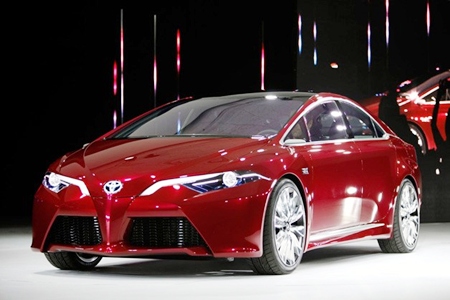Toyota wants you to be ready for a PIH, as at the North American International Auto Show Toyota revealed the NS4 – an advanced plug-in hybrid (PIH) concept vehicle. The NS4 is Toyota’s vision for future mobility, with a focus on next generation connectivity and safety. A big ask to wrap into one vehicle, but you’ve got to hand it to Toyota, they gave it a go.
Jim Lentz, president and chief executive officer of Toyota Motor Sales US (Inc.) said, “In this digital age, cars are becoming another spoke in the wheel of our electronic connectivity. NS4 demonstrates Toyota’s take on the human connection to the car with technology that considers both emotional and rational relationships, person-to-car and car-to-society.”
 Toyota NS4.
Toyota NS4.
NS4 has an advanced power train features a hybrid plug-in system of light weight with improved overall fuel economy, better acceleration and longer all-electric range, while maintaining a short charge time. The question is, has Toyota found the holy grail?
Vehicles have become another communication hub in the consumer’s lifestyle, and are the third-fastest growing technological device, behind smartphones and tablets. (However, I don’t think the Thai government will be giving us all an NS4.) Toyota has formed special alliances with technology leaders such as Microsoft, Intel and Salesforce to explore the creation of seamless vehicle interfaces with emerging technologies.
The NS4 concept’s human-machine interface (HMI) is centered around a multi-touch screen with the look and feel of a smartphone. The simple, intuitive operation conveys information quickly while minimizing distractions and maximizing driver awareness. The multimedia and vehicle-controls enhancement will also direct air conditioning, audio, battery-charge and navigation functions. The HMI system is even capable of “learning” driver preferences to anticipate driver responses in specific environments and situations. This all worries me a little. Think BMW iDrive where you go through drop-down menu after menu looking for some way to turn on the A/C.
The safety side looks a reasonable approach by Toyota. The NS4 features their latest safety system developments, the whole alphabet full, including next generation pre-collision system (PCS), adaptive driving beam (ADB) headlights, and blind spot monitor (BSM). PCS features lane departure and pedestrian collision avoidance technologies designed to predict collisions under certain circumstances and help avoid them. The system uses millimeter-wave radar and stereo cameras mounted on the front of the vehicle to detect and react to lane departure, pedestrians, and other vehicles. In the event of a potential collision, the system seeks to avoid other vehicles, road-side obstructions, and pedestrians by applying the brakes and manipulating steering.
Adaptive Driving Beam (ADB) headlights help to prevent blinding glare to oncoming drivers and pedestrians. Using a camera mounted behind the front grille and partial shielding inside the headlights, this feature allows drivers to maintain near-high beam illumination to improve night visibility.
Using sub-millimeter wave radar, the Blind Spot Monitor (BSM) detects a vehicle in the adjacent lane and visually alerts the driver using visual indicators placed in the upper dash.
Four new glass technologies are integrated into the windscreen, front and rear windows to improve driver visibility, fuel economy and electric driving mode mileage efficiency:
Rain-resistant ‘hydrophobic’ coating – Fluorine coated glass causes rain drops to form into semispherical shapes for improved visibility and rain drop elimination. ‘Anti-fog’ coating – high performance resin material with anti-fogging characteristics and increased durability. High ultraviolet (UV) absorbing inner-layer – removes 99 percent of harmful UVA and UVB rays and Anti-solar film with radio-wave transparency – reduces the internal vehicle temperature and improves electronic device functionality.
Inner and outer rear view mirrors have been replaced with cameras that provide the driver with a panoramic view to the rear. The rear-view camera displays images on a dashboard-mounted screen, and provides the driver with a much wider field of vision when compared to a traditional rear view mirror.
How much of all this technology will become commonplace in the next five years is probably anybody’s guess. But it is coming, Toyota said so!




